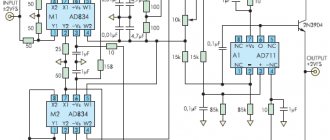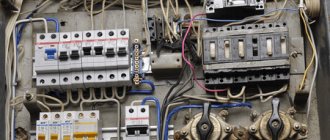What is alternating current: definition
Everyone has heard this term, but not everyone knows what it means. Variable is the chaotic movement of charged particles, changing its polarity from plus to minus with a certain frequency, which is measured in hertz (Hz). If you draw a graph, then such a value will look like a sinusoid periodically crossing the “X” coordinate axis. If we talk about three-phase current, then it flows not through one conductor, but through three. The phase sinusoids are ideally completely identical, but shifted relative to each other by 120 degrees.
Alternating current is found everywhere. It is produced at power plants by generators with various drives. Such current is easy to transmit over various distances and it is quite easy to obtain a constant current from it, which cannot be said about the reverse transformation. For “transportation” with minimal losses, the voltage is increased to 25 kV, as a result of which, according to the laws of physics, the current strength, measured in amperes (A), is reduced. When it reaches the desired point, it goes to the primary transformer substation. The voltage on it is reduced to 6 kV and sent further. The last transformer further reduces the voltage to the usual 0.4 kV (400V). It is this current that enters apartment buildings in three phases. Here the phases are evenly distributed, as a result of which 1 phase is supplied to each dwelling, capable of providing the premises with an electrical voltage of 220 V.
So what is the current in the outlet? Of course it is variable. Almost all household appliances work on it. If the device requires direct current, special transformers with rectifiers (diode bridges), called adapters, are used. Televisions, computers, and stereo systems are often equipped with similar power supplies.
Direct current: features
Its strength and direction are unchanged. Here, conductors carry a certain charge - positive or negative. In everyday life, not only adapters are responsible for generating DC current. It can be obtained from batteries and galvanic cells. DC voltages in everyday life are small - usually from 1.5 V to 24 V.
In industry it is used for motors with high starting currents. This allows for smooth adjustment of the rotation speed. Here, direct current is generated by special generators that create vortex flows of the electromagnetic field.
What You Should Know About Amperage and Voltage
It is not enough to know what current is in the outlet - alternating or direct. There are many other factors to consider. Many people believe that the higher its voltage, the more dangerous it is. In fact, everything is quite the opposite. As already mentioned, with increasing voltage the current strength decreases, and in case of damage, this parameter is dangerous for the body. But this statement is true only for a constant value. Alternating current does not have a specific strength - this parameter will depend on the load. The more devices are plugged into a 220-volt electrical outlet, the higher this value is in the conductor. The increase in this parameter will be limited by automatic protective equipment, which will not allow the current strength to increase to critical limits, turning off the power to the home network.
How three-phase current is converted to single-phase
It remains to figure out why we use single-phase current with a voltage whose value is exactly 220 Volts. To do this, it is necessary to trace the path and transformation of electricity from the power plant to the outlet in the consumer’s home.
Powerful power plants generate voltages of the order of 200-300 thousand volts, then this electricity is transmitted via high-voltage power lines to group distribution substations serving cities, regions, and large industrial enterprises. Here the voltage is reduced, as a rule, to 6000 Volts and the further supply of electricity to step-down substations, the transformers of which reduce the high voltage to 380 Volts.
What current flows into the outlet: characteristics of household voltage
The standard voltage of a household network between phase and neutral is 220-240 V. The current strength depends on the number of consumers and their characteristics. Let's try to calculate the parameters when connecting a washing machine with a water heater with a power of 2.5 kW. To find out what current strength will be present in the outlet when connecting such equipment, it is necessary to clarify some values. For calculations you will need the power factor. It is indicated in the technical documentation and on the device nameplate. If this indicator is missing, a value of 0.95 is taken for calculation.
To find out the current strength that occurs when the water heater is turned on, you need to multiply the voltage by the power factor, and then divide the 2.5 kW that the washing machine consumes by the resulting value. The calculations will look like this: 2500 W / (220 × 0.95) = 11.96 A. It turns out that a regular cheap 220 V electrical outlet will not be suitable for such equipment - its maximum is 10 A. You will have to purchase a more expensive product that can withstand up to 16 A.
How can you measure AC voltage?
You can change the variable network voltage, like any other electrical characteristics of the network, using special measuring instruments: voltmeters, ammeters, ohmmeters. Modern testers and multimeters contain the functions of all of them, so it is better to use them. In order to measure a parameter, follow the instructions:
Find the measurement scale on the device, which is most often located on the right. Set the measurement limit, knowing that, for example, there is approximately 220 volts in the outlet. Take the probes and insert them into the source
It does not matter which probe is inserted where. Make measurements taking into account safety precautions. Record the obtained indicators.
Thus, there is a difference between direct voltage and alternating voltage, and it is significant. Based on constant and intermittent current forces, generators have been manufactured that convert mechanical energy into electrical current of various types, which can be supplied faster and further through wires.
Safety automation: how it can save lives
By rewriting all the data of household appliances connected to a certain line, you can determine what current is generated in household sockets when all equipment is turned on at the same time. This will allow you to select protective devices with suitable parameters. Many people underestimate the role of RCDs in the power supply circuit, believing that a conventional circuit breaker is quite sufficient. However, these devices have completely different purposes.
The circuit breaker is designed to force or emergency open the circuit in the event of an overload or short circuit. But it is not able to protect a person from electric shock if the insulation of a current-carrying conductor is damaged and it comes into contact with open areas of the body. But this work is successfully performed by the RCD. If the room is equipped with sockets with grounding, then in the event of a breakdown, a current leak occurs, which is detected by the residual current device, instantly interrupting the power supply. The only problem with an RCD is that it does not respond to a short circuit, as a result of which it can burn out. It is for this reason that the residual current device is mounted in conjunction with a circuit breaker.
Rated current of the consumer
Any device used in electrical networks of direct or alternating voltage has certain parameters. One of them is the rated current.
This characteristic shows how many amperes can be passed through the main electrical circuit of the device over a long period of time.
In this regard, electrical outlets are no exception to the rule. They can also be divided according to their current rating. Standard values for single-phase household appliances are 6, 10, 16, 25 and 32 amps.
USEFUL INFORMATION: Symbol of the socket in the diagram
Sockets for 6 - 16 amperes are most often used and can be combined into groups that receive power via a dedicated line from the apartment electrical panel. Devices with a rated current of 25 amperes are designed to power more powerful consumers.
As for 32-amp sockets, they are produced in most cases in a three-phase design and are designed to connect especially powerful consumers, such as electric stoves or hobs.
Mains voltage and its changes
It is clear that the question of how many amperes the current is in an outlet is incorrect - this is a changeable quantity. But why can the voltage in the network drop or rise sharply? Most often, there are two reasons for the occurrence of such problems - a worn-out transformer at the substation that requires replacement and unqualified electricians who disconnected the phases before putting the house into operation. If everything is more or less clear with the first option, then it is worth dwelling on the second in more detail.
Causes of phase imbalance and its consequences for household appliances
If there are three apartments on the site, then the connection is made as follows - a common zero for all rooms and one of three phases for each. In this case, the riser is replaced on each floor. If in the first phase the third phase is connected to a two-room apartment, in the second it will go to a four-room apartment, and even higher it will power a one-room apartment. This alternation allows you to evenly distribute the load. If you run one phase through all the four-room apartments of the entrance, and even imagine a cold winter with the need to use electric radiators, it is easy to understand how the network is overloaded. In this case, the line voltage may drop. Due to phase imbalance, additional load will be placed on the transformer.
Now let’s imagine that people are returning from work (usually at the same time), it’s warmer outside, so the radiators in several apartments are turned off at once. The result is predictable - a power surge and possible failure of household appliances. This often happens in apartments with incorrectly selected automation and a lack of grounded sockets.
Requirements for plug connections
To connect an electrical appliance to the network, a socket and plug are respectively a source and receiver of energy, forming a plug connection. The following requirements apply to it.
Reliable contact. A weak connection leads to overheating and failure.
It is also important to ensure reliable fixation against spontaneous disconnection. Here it is convenient to use spring contacts in the socket. Isolation of current-carrying parts from each other. Protection against touching live parts with hands or other objects
To protect against children, sockets are provided with special curtains that open only when the plug is inserted. Ensuring polarity when connecting. This is important if the connection carries direct current or the device is used in combination with a single-pole switch. The design of the socket does not allow incorrect connection. Availability of grounding for devices of protection class 1. It is important to properly connect the grounding in sockets.
Some tips for choosing RCD and AB sockets
The first step is to write down separately the power of all household appliances, dividing them into groups from which they will be powered. By calculating what current in the outlet will be maximum, you can determine the parameters of the circuit breaker and RCD required for a particular line. If a general residual current device is planned, then all current indicators are added up. This is quite acceptable, but it should be remembered that each group must have a separate circuit breaker. It is installed after the RCD, which is powered by an electricity meter. Here, between the meter and the residual current device, it is necessary to install a common circuit breaker. It will protect the RCD in case of a short circuit or heating of the wiring. Another place for mandatory installation of an automatic or batch switch is in front of the electric meter. It is used when it is necessary to replace or service a metering device.
Summing up
Information on the question of what current is in the socket has become clear - variable. Its value is not determined and depends only on the power consumption of household appliances connected to the network. The network voltage is 220-240 V. For a home handyman who is not professionally involved in electrical engineering, these characteristics are quite enough. If you need to calculate the current strength in your home network at full load, you can always use the calculations presented in the article. This may be necessary to select protective automation with the necessary parameters, as well as when completely replacing electrical wiring.
Practical significance of the differences
This is what it is, alternating and direct current. It's not that difficult to figure out what the difference is. There is a difference and a very big one. A DC source will not allow you to connect a welding, or any other, transformer. When calculating insulation or capacitors, the maximum voltage value, rather than the effective voltage, is taken for breakdown. After all, the thought may certainly arise: “why do you need 400-volt capacitors in a 220-volt network?” Here is the answer, in a 220 V network the voltage reaches 380 V during normal operation, and in the event of a minor failure, 400 V is not the limit.
People have long been accustomed to the benefits of electricity and many do not care what current is in the outlet. On the planet, 98% of electricity generated is alternating current. It is much easier to produce and transmit over significant distances than constant. In this case, the voltage can change many times in value down and up. The current strength significantly affects the losses in the wires.
Transmission of electricity over a distance
The parameters of the home network are always known: alternating current, voltage 220 volts and frequency 50 hertz.
They are mainly suitable for electric motors, refrigerators and vacuum cleaners, as well as incandescent lamps and many other devices. Many consumers operate at a constant voltage of 6-12 volts. This especially applies to electronics. But the power supply of the devices must be of the same type. Therefore, for all consumers, the current in the outlet must be variable, with the same voltage and frequency.










